Unit 6 When was it invented? Section A 3a-3c 教学设计(表格式)2024-2025学年人教版英语九年级全册
文档属性
| 名称 | Unit 6 When was it invented? Section A 3a-3c 教学设计(表格式)2024-2025学年人教版英语九年级全册 |
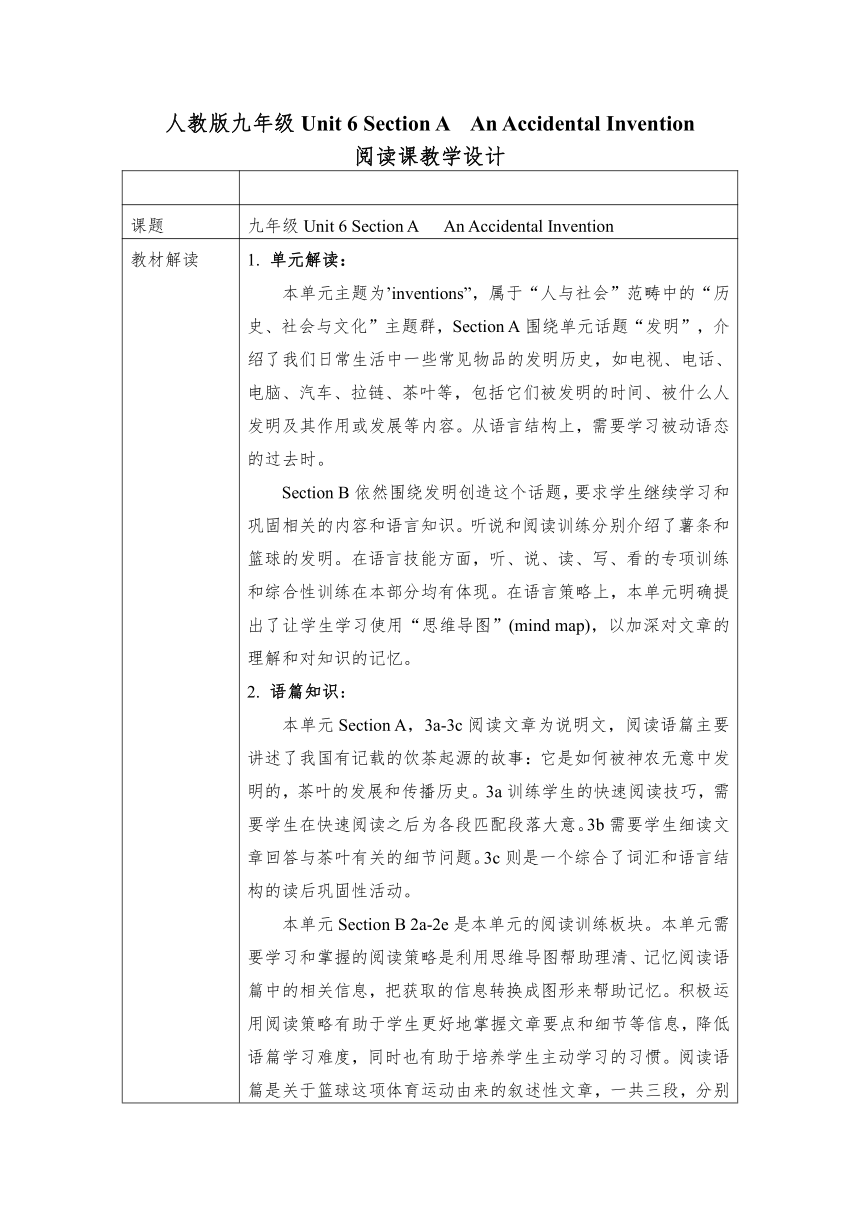
|
|
| 格式 | docx | ||
| 文件大小 | 930.4KB | ||
| 资源类型 | 教案 | ||
| 版本资源 | 人教新目标(Go for it)版 | ||
| 科目 | 英语 | ||
| 更新时间 | 2024-06-27 09:40:40 | ||
图片预览

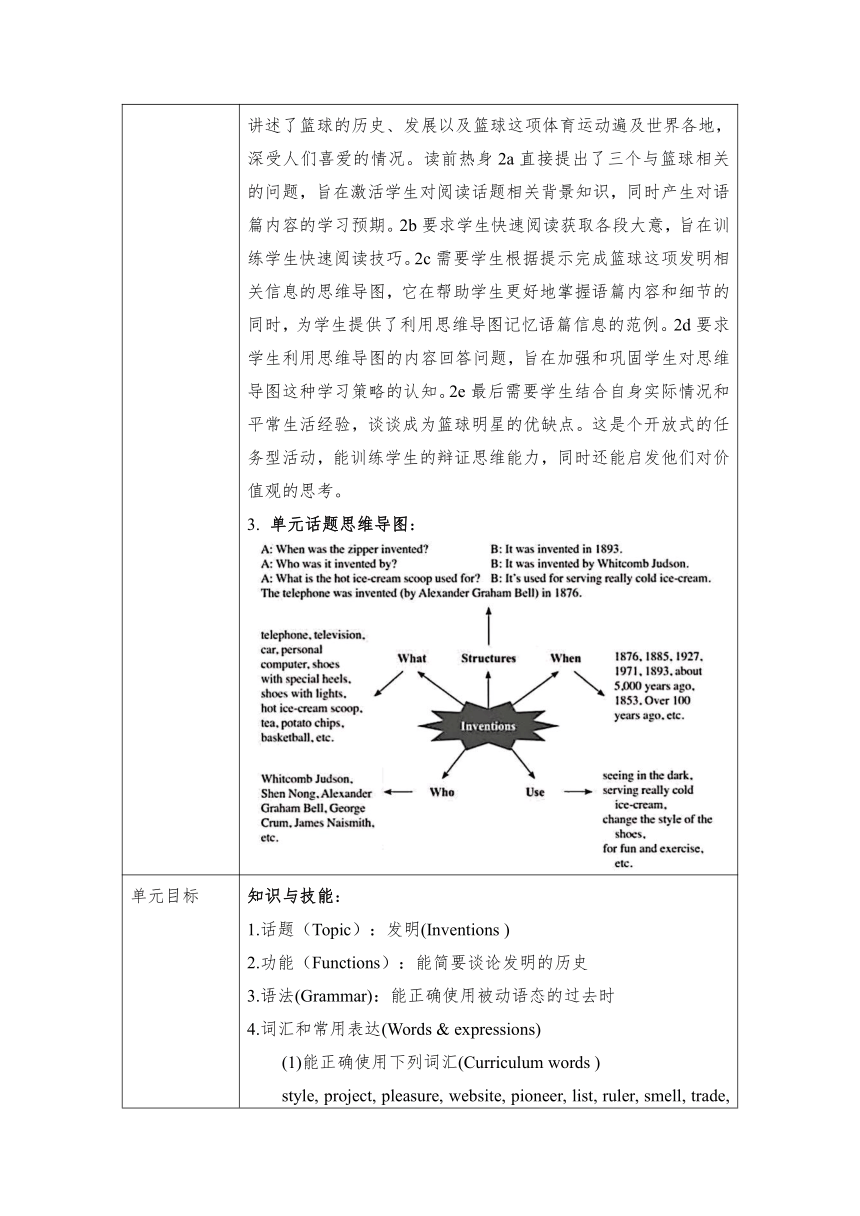
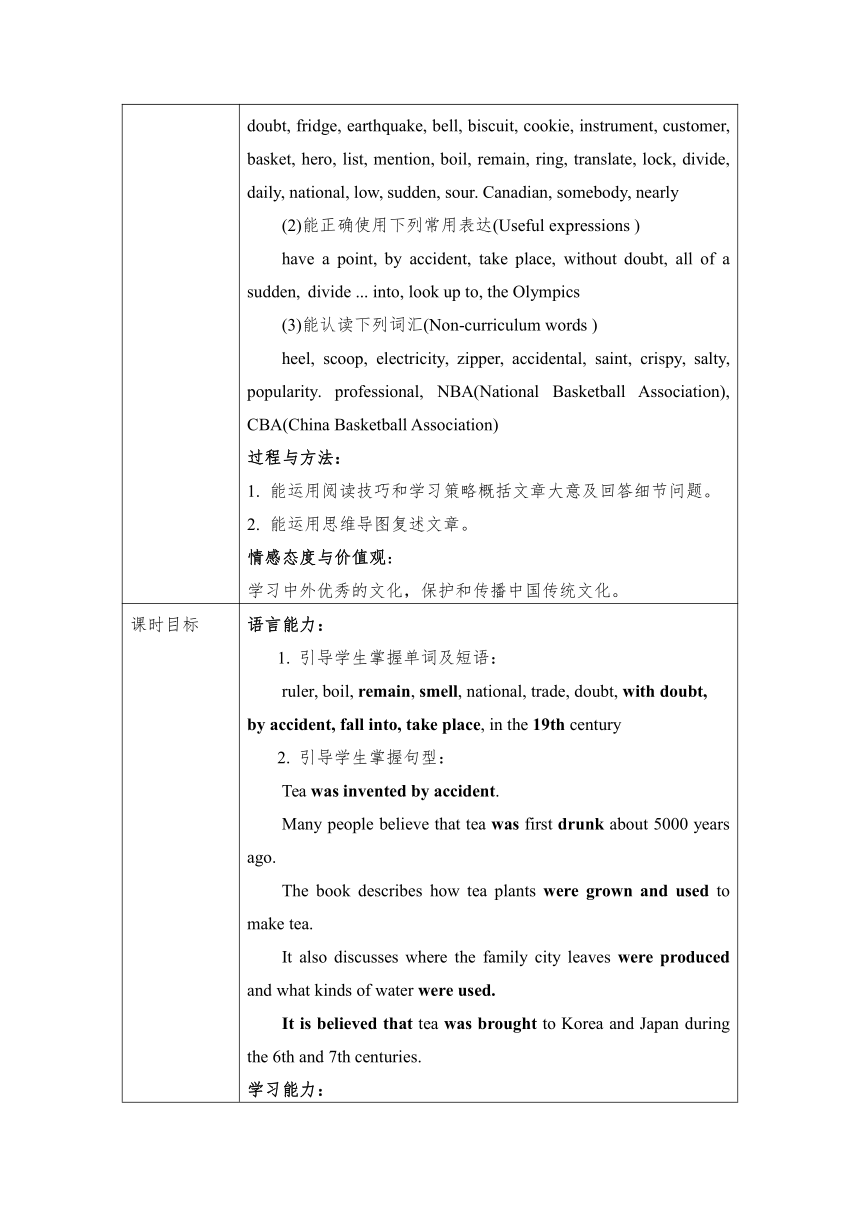
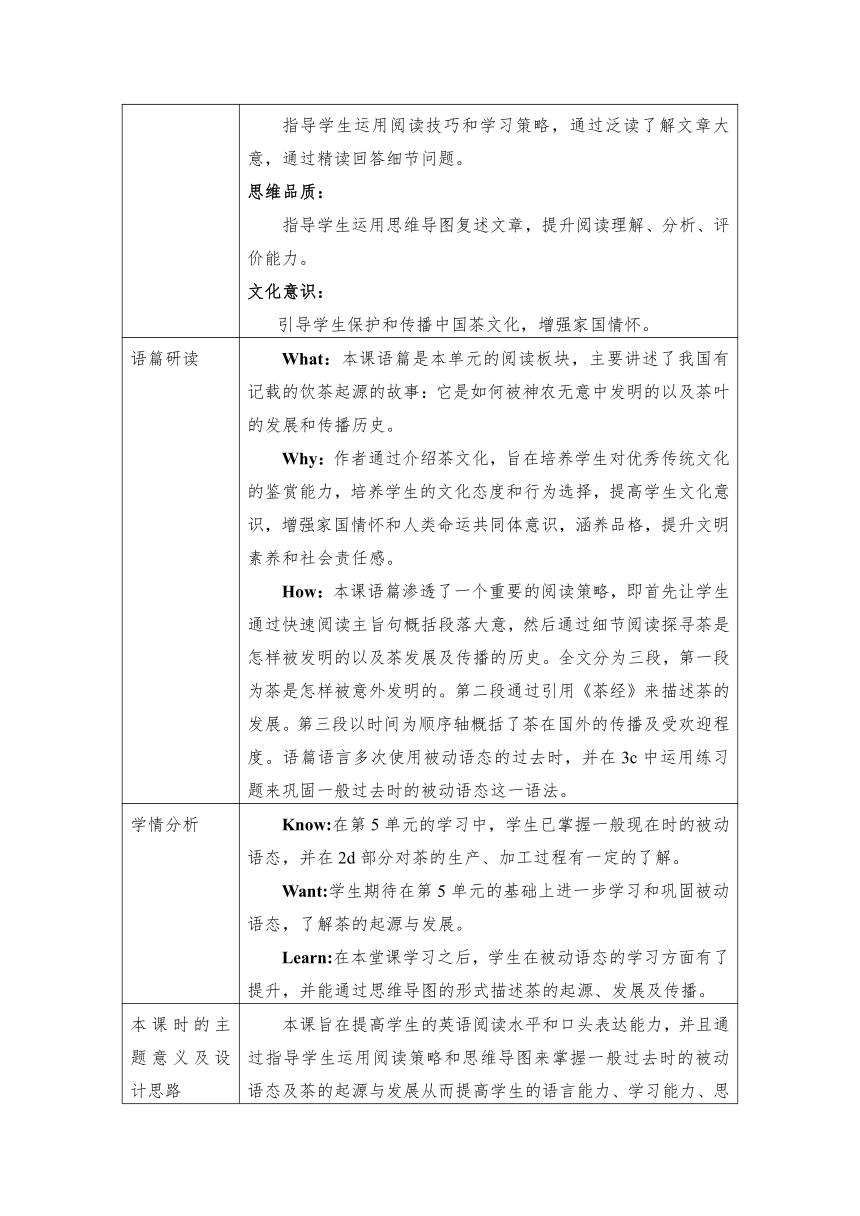
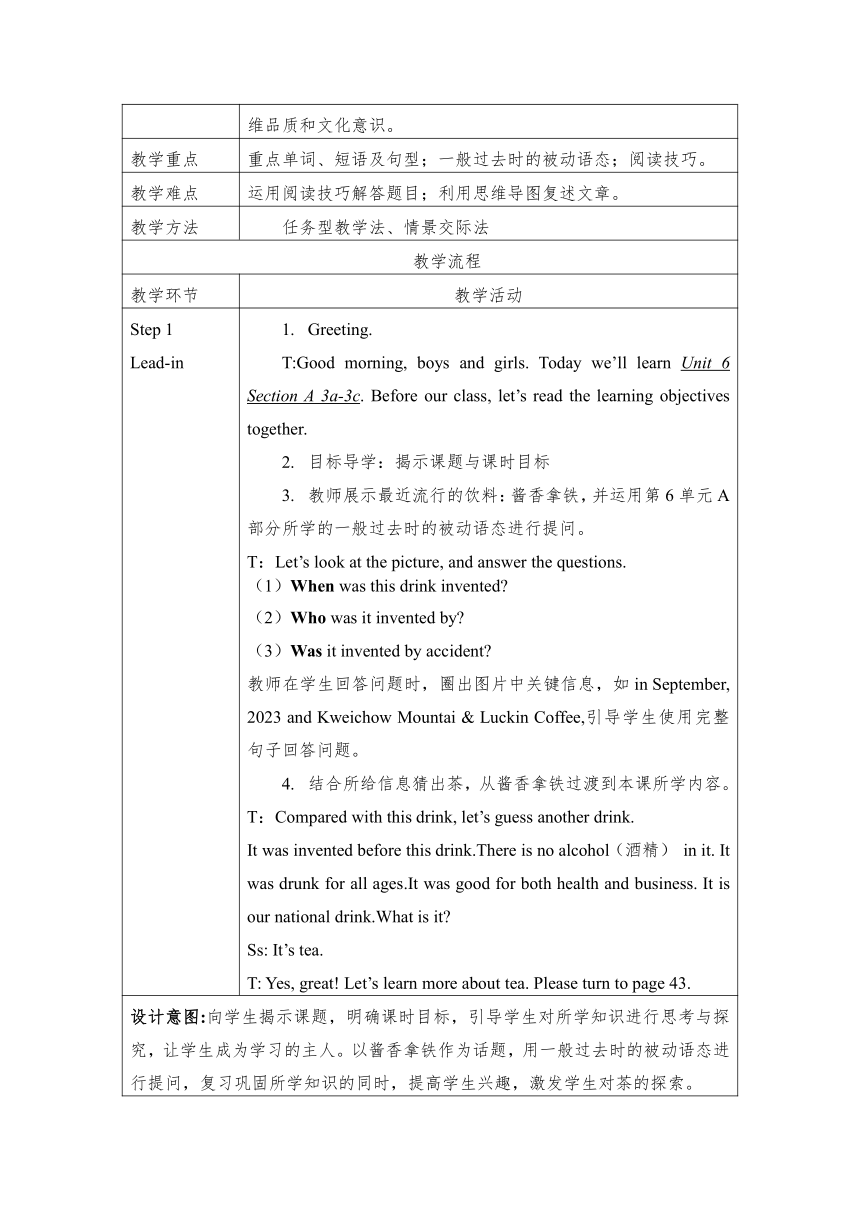
文档简介
人教版九年级Unit 6 Section A An Accidental Invention
阅读课教学设计
课题 九年级Unit 6 Section A An Accidental Invention
教材解读 单元解读: 本单元主题为’inventions”,属于“人与社会”范畴中的“历史、社会与文化”主题群,Section A围绕单元话题“发明”,介绍了我们日常生活中一些常见物品的发明历史,如电视、电话、电脑、汽车、拉链、茶叶等,包括它们被发明的时间、被什么人发明及其作用或发展等内容。从语言结构上,需要学习被动语态的过去时。 Section B依然围绕发明创造这个话题,要求学生继续学习和巩固相关的内容和语言知识。听说和阅读训练分别介绍了薯条和篮球的发明。在语言技能方面,听、说、读、写、看的专项训练和综合性训练在本部分均有体现。在语言策略上,本单元明确提出了让学生学习使用“思维导图”(mind map),以加深对文章的理解和对知识的记忆。 语篇知识: 本单元Section A,3a-3c阅读文章为说明文,阅读语篇主要讲述了我国有记载的饮茶起源的故事:它是如何被神农无意中发明的,茶叶的发展和传播历史。3a训练学生的快速阅读技巧,需要学生在快速阅读之后为各段匹配段落大意。3b需要学生细读文章回答与茶叶有关的细节问题。3c则是一个综合了词汇和语言结构的读后巩固性活动。 本单元Section B 2a-2e是本单元的阅读训练板块。本单元需要学习和掌握的阅读策略是利用思维导图帮助理清、记忆阅读语篇中的相关信息,把获取的信息转换成图形来帮助记忆。积极运用阅读策略有助于学生更好地掌握文章要点和细节等信息,降低语篇学习难度,同时也有助于培养学生主动学习的习惯。阅读语篇是关于篮球这项体育运动由来的叙述性文章,一共三段,分别讲述了篮球的历史、发展以及篮球这项体育运动遍及世界各地,深受人们喜爱的情况。读前热身2a直接提出了三个与篮球相关的问题,旨在激活学生对阅读话题相关背景知识,同时产生对语篇内容的学习预期。2b要求学生快速阅读获取各段大意,旨在训练学生快速阅读技巧。2c需要学生根据提示完成篮球这项发明相关信息的思维导图,它在帮助学生更好地掌握语篇内容和细节的同时,为学生提供了利用思维导图记忆语篇信息的范例。2d要求学生利用思维导图的内容回答问题,旨在加强和巩固学生对思维导图这种学习策略的认知。2e最后需要学生结合自身实际情况和平常生活经验,谈谈成为篮球明星的优缺点。这是个开放式的任务型活动,能训练学生的辩证思维能力,同时还能启发他们对价值观的思考。 单元话题思维导图:
单元目标 知识与技能: 1.话题(Topic):发明(Inventions ) 2.功能(Functions):能简要谈论发明的历史 3.语法(Grammar):能正确使用被动语态的过去时 4.词汇和常用表达(Words & expressions) (1)能正确使用下列词汇(Curriculum words ) style, project, pleasure, website, pioneer, list, ruler, smell, trade, doubt, fridge, earthquake, bell, biscuit, cookie, instrument, customer, basket, hero, list, mention, boil, remain, ring, translate, lock, divide, daily, national, low, sudden, sour. Canadian, somebody, nearly (2)能正确使用下列常用表达(Useful expressions ) have a point, by accident, take place, without doubt, all of a sudden, divide ... into, look up to, the Olympics (3)能认读下列词汇(Non-curriculum words ) heel, scoop, electricity, zipper, accidental, saint, crispy, salty, popularity. professional, NBA(National Basketball Association), CBA(China Basketball Association) 过程与方法: 能运用阅读技巧和学习策略概括文章大意及回答细节问题。 能运用思维导图复述文章。 情感态度与价值观: 学习中外优秀的文化,保护和传播中国传统文化。
课时目标 语言能力: 引导学生掌握单词及短语: ruler, boil, remain, smell, national, trade, doubt, with doubt, by accident, fall into, take place, in the 19th century 引导学生掌握句型: Tea was invented by accident. Many people believe that tea was first drunk about 5000 years ago. The book describes how tea plants were grown and used to make tea. It also discusses where the family city leaves were produced and what kinds of water were used. It is believed that tea was brought to Korea and Japan during the 6th and 7th centuries. 学习能力: 指导学生运用阅读技巧和学习策略,通过泛读了解文章大意,通过精读回答细节问题。 思维品质: 指导学生运用思维导图复述文章,提升阅读理解、分析、评价能力。 文化意识: 引导学生保护和传播中国茶文化,增强家国情怀。
语篇研读 What:本课语篇是本单元的阅读板块,主要讲述了我国有记载的饮茶起源的故事:它是如何被神农无意中发明的以及茶叶的发展和传播历史。 Why:作者通过介绍茶文化,旨在培养学生对优秀传统文化的鉴赏能力,培养学生的文化态度和行为选择,提高学生文化意识,增强家国情怀和人类命运共同体意识,涵养品格,提升文明素养和社会责任感。 How:本课语篇渗透了一个重要的阅读策略,即首先让学生通过快速阅读主旨句概括段落大意,然后通过细节阅读探寻茶是怎样被发明的以及茶发展及传播的历史。全文分为三段,第一段为茶是怎样被意外发明的。第二段通过引用《茶经》来描述茶的发展。第三段以时间为顺序轴概括了茶在国外的传播及受欢迎程度。语篇语言多次使用被动语态的过去时,并在3c中运用练习题来巩固一般过去时的被动语态这一语法。
学情分析 Know:在第5单元的学习中,学生已掌握一般现在时的被动语态,并在2d部分对茶的生产、加工过程有一定的了解。 Want:学生期待在第5单元的基础上进一步学习和巩固被动语态,了解茶的起源与发展。 Learn:在本堂课学习之后,学生在被动语态的学习方面有了提升,并能通过思维导图的形式描述茶的起源、发展及传播。
本课时的主题意义及设计思路 本课旨在提高学生的英语阅读水平和口头表达能力,并且通过指导学生运用阅读策略和思维导图来掌握一般过去时的被动语态及茶的起源与发展从而提高学生的语言能力、学习能力、思维品质和文化意识。
教学重点 重点单词、短语及句型;一般过去时的被动语态;阅读技巧。
教学难点 运用阅读技巧解答题目;利用思维导图复述文章。
教学方法 任务型教学法、情景交际法
教学流程
教学环节 教学活动
Step 1 Lead-in Greeting. T:Good morning, boys and girls. Today we’ll learn Unit 6 Section A 3a-3c. Before our class, let’s read the learning objectives together. 目标导学:揭示课题与课时目标 教师展示最近流行的饮料:酱香拿铁,并运用第6单元A部分所学的一般过去时的被动语态进行提问。 T:Let’s look at the picture, and answer the questions. (1)When was this drink invented (2)Who was it invented by (3)Was it invented by accident 教师在学生回答问题时,圈出图片中关键信息,如in September, 2023 and Kweichow Mountai & Luckin Coffee,引导学生使用完整句子回答问题。 结合所给信息猜出茶,从酱香拿铁过渡到本课所学内容。 T:Compared with this drink, let’s guess another drink. It was invented before this drink.There is no alcohol(酒精) in it. It was drunk for all ages.It was good for both health and business. It is our national drink.What is it Ss: It’s tea. T: Yes, great! Let’s learn more about tea. Please turn to page 43.
设计意图:向学生揭示课题,明确课时目标,引导学生对所学知识进行思考与探究,让学生成为学习的主人。以酱香拿铁作为话题,用一般过去时的被动语态进行提问,复习巩固所学知识的同时,提高学生兴趣,激发学生对茶的探索。 效果评价:观察学生用一般过去时的被动语态对酱香拿铁相关问题的回答,从而评价学生对一般过去时的被动语态的掌握程度。
Step 2 Pre-reading Let's predict. T: Before we learn the passage, let’ predict what the passage is mainly about Kinds of tea and how to boil tea. The invention and some culture of tea. S: B. The invention and some culture of tea. T: How do you know it S: I found the answers from the title and the picture. T: How smart you are! Let’s read the title together. 教师运用升降调带读标题An Accidental Invention三遍,并随机检测一组学生是否会读。 T: Group 1, please read the title one by one. Ss: An Accidental Invention. T: Good! / Great!/ Perfect! / Excellent!/ Good job!/ Well done!/ You are so smart!… 教师使用不同的评价语对学生的反应进行反馈与评价,激励学生大声朗读。
设计意图:引导学生快速阅读标题及观察插图,推出文章大意。 效果评价:观察学生谈论标题的含义是否符合语篇的内容。
Step 3 While-reading Task 1: Fast-reading T: We have known tea is an accidental invention. Let’s learn more about it. Please read the passage quickly and match each paragraph with its main idea. (Tips: find out the topic sentences.) Para. 1 Para. 2 Para. 3Lu Yu and his book Cha Jing How tea spread to other countries How tea was invented by accident.
Task 2: Careful-reading Read Para.1 carefully and answer the questions. T: As we have mastered the main ideas of each paragraph, let’s learn some details of the invention. Please read Para.1 carefully and answer the questions. (Tips: find out the key words and phrases.) When was tea first drunk __________________________________________ Who was it invented by __________________________________________ 3. Was tea invented by accident __________________________________________ Fill in the blanks. T: From Para. 1 we’ve learned that tea was invented by accident, but how was tea invented Let’s find out the process. Please fill in the blanks by yourself. (Tips: pay attention to the verbs) Shen Nong was _________ drinking water when some leaves _______ ________ the water and __________ there for some time. It __________ a pleasant smell. Shen Nong ________ the brown water and it tasted delicious. T: Who’d like to write down the answers on the blackboard 教师邀请一位同学将答案写在黑板上,并邀请全班同学一起核对答案,然后对该同学进行点评。如:I’m so happy that your answers are all right.然后教师对全班同学的作答情况进行反馈,如:If your answers are all right, please hands up. 教师及时关注学生作答情况,并进行表扬与鼓励:如;Amazing! Most of you did a good job! Read Para.2 and answer the questions. T: Since we’ve learned the history of tea, let’s explore the development of tea. Please read Para.2 quickly and answer the questions. 1.Who is called "the sage of tea" __________________________________________ 2.What is Cha Jing about __________________________________________ Listen to Para.3 and fill in the blanks. T: As we know Chinese tea have become more and more popular.Do you know when tea was brought to other countries Let’s listen to the tape carefully and fill in the blanks.(Tips: please pay attention to the time and places.)
设计意图:引导学生快速浏览文章,找出段落大意,了解文章篇章布局和结构,为细节阅读奠定基础。引导学生细读每段,完成三个段落的活动任务,如阅读简答、摘录要点听写,表格填空等,帮助学生构建思维导图,有利于复述课文,提高学生的语言能力和学习能力。 效果评价:观察学生是否在规定时间内完成阅读任务,检测学生对文章段落的理解及分析情况。
Step 4 Post-reading Finish 3c. (Tips: pay attention to the passive voice.) Your foreign friend, Michael is interested in Chinese tea culture. Please introduce it to him by making a mind map.(Tips: 4 students a group. One student draw a mind map. One student note the key words, such as when, who, what, how, where and so on. One student write down the sentences, and the last student is required to give a report.) 教师向学生展示如何制作思维导图的视频,并指导学生在小组合作中结合思维导图用英语介绍中国茶文化。教师对上台展示的同学给予鼓励与肯定,如:You did a good job. Give me five. / Your voice and pronunciation are pretty good. I love you, please give me a hug. / You love Chinese tea culture. I love your performance… What do you think of Chinese tea culture Why S:… T:I think our Chinese tea culture is popular and valuable. Why Let’s enjoy a video to find the answers. T: From the video we know that even though many people now know about tea culture, the Chinese are without doubt the ones who best understand the nature of tea. So let's protect and spread the Chinese tea culture.
设计意图:创设情境,让学生以小组合作探究的形式构建思维导图,描述茶的起源、发展及传播的过程,提升学生的理解、分析、创造等思维品质。通过询问学生对中国茶文化的看法及原因,引导学生保护和传播茶文化,提高文化意识。 效果评价:观察学生 小组合作过程中,学生分工是否明确,能否利用思维导图描述茶的起源、发展及传播过程。
Step 5 Summary
设计意图:以表格的形式,引导学生对学习目标进行复盘检测,并进行自我总结与评价,体现“教--学--评”一体化的教学模式。 效果评价:观察学生是否能对照学习目标进行自我评价。
Homework Must do:Level 1:熟读课文,完成《学法》1-10题。 Level 2:尝试复述课文,完成《学法》1-15题。 Choose to do: Research on grinding tea in terms of its origin,making progress,tea customs,and diffusing can enhance our knowledge of grinding tea culture,and thus we can enhance the protection and development of it. 调查擂茶的起源、制作方法、茶俗、传播等进行研究,试图加深对擂茶文化内涵的理解,以此促进擂茶的保护及发展。
设计意图:根据学生的学情分层布置作业,包括基础类、拓展类及创新类作业,给学生减轻作业负担的同时,尊重个体差异,提高学生核心素养。 效果评价:观察学生不同层次作业的完成情况。
板书设计 An Accidental Invention
教学反思 优点: 缺点: 改进措施:
阅读课教学设计
课题 九年级Unit 6 Section A An Accidental Invention
教材解读 单元解读: 本单元主题为’inventions”,属于“人与社会”范畴中的“历史、社会与文化”主题群,Section A围绕单元话题“发明”,介绍了我们日常生活中一些常见物品的发明历史,如电视、电话、电脑、汽车、拉链、茶叶等,包括它们被发明的时间、被什么人发明及其作用或发展等内容。从语言结构上,需要学习被动语态的过去时。 Section B依然围绕发明创造这个话题,要求学生继续学习和巩固相关的内容和语言知识。听说和阅读训练分别介绍了薯条和篮球的发明。在语言技能方面,听、说、读、写、看的专项训练和综合性训练在本部分均有体现。在语言策略上,本单元明确提出了让学生学习使用“思维导图”(mind map),以加深对文章的理解和对知识的记忆。 语篇知识: 本单元Section A,3a-3c阅读文章为说明文,阅读语篇主要讲述了我国有记载的饮茶起源的故事:它是如何被神农无意中发明的,茶叶的发展和传播历史。3a训练学生的快速阅读技巧,需要学生在快速阅读之后为各段匹配段落大意。3b需要学生细读文章回答与茶叶有关的细节问题。3c则是一个综合了词汇和语言结构的读后巩固性活动。 本单元Section B 2a-2e是本单元的阅读训练板块。本单元需要学习和掌握的阅读策略是利用思维导图帮助理清、记忆阅读语篇中的相关信息,把获取的信息转换成图形来帮助记忆。积极运用阅读策略有助于学生更好地掌握文章要点和细节等信息,降低语篇学习难度,同时也有助于培养学生主动学习的习惯。阅读语篇是关于篮球这项体育运动由来的叙述性文章,一共三段,分别讲述了篮球的历史、发展以及篮球这项体育运动遍及世界各地,深受人们喜爱的情况。读前热身2a直接提出了三个与篮球相关的问题,旨在激活学生对阅读话题相关背景知识,同时产生对语篇内容的学习预期。2b要求学生快速阅读获取各段大意,旨在训练学生快速阅读技巧。2c需要学生根据提示完成篮球这项发明相关信息的思维导图,它在帮助学生更好地掌握语篇内容和细节的同时,为学生提供了利用思维导图记忆语篇信息的范例。2d要求学生利用思维导图的内容回答问题,旨在加强和巩固学生对思维导图这种学习策略的认知。2e最后需要学生结合自身实际情况和平常生活经验,谈谈成为篮球明星的优缺点。这是个开放式的任务型活动,能训练学生的辩证思维能力,同时还能启发他们对价值观的思考。 单元话题思维导图:
单元目标 知识与技能: 1.话题(Topic):发明(Inventions ) 2.功能(Functions):能简要谈论发明的历史 3.语法(Grammar):能正确使用被动语态的过去时 4.词汇和常用表达(Words & expressions) (1)能正确使用下列词汇(Curriculum words ) style, project, pleasure, website, pioneer, list, ruler, smell, trade, doubt, fridge, earthquake, bell, biscuit, cookie, instrument, customer, basket, hero, list, mention, boil, remain, ring, translate, lock, divide, daily, national, low, sudden, sour. Canadian, somebody, nearly (2)能正确使用下列常用表达(Useful expressions ) have a point, by accident, take place, without doubt, all of a sudden, divide ... into, look up to, the Olympics (3)能认读下列词汇(Non-curriculum words ) heel, scoop, electricity, zipper, accidental, saint, crispy, salty, popularity. professional, NBA(National Basketball Association), CBA(China Basketball Association) 过程与方法: 能运用阅读技巧和学习策略概括文章大意及回答细节问题。 能运用思维导图复述文章。 情感态度与价值观: 学习中外优秀的文化,保护和传播中国传统文化。
课时目标 语言能力: 引导学生掌握单词及短语: ruler, boil, remain, smell, national, trade, doubt, with doubt, by accident, fall into, take place, in the 19th century 引导学生掌握句型: Tea was invented by accident. Many people believe that tea was first drunk about 5000 years ago. The book describes how tea plants were grown and used to make tea. It also discusses where the family city leaves were produced and what kinds of water were used. It is believed that tea was brought to Korea and Japan during the 6th and 7th centuries. 学习能力: 指导学生运用阅读技巧和学习策略,通过泛读了解文章大意,通过精读回答细节问题。 思维品质: 指导学生运用思维导图复述文章,提升阅读理解、分析、评价能力。 文化意识: 引导学生保护和传播中国茶文化,增强家国情怀。
语篇研读 What:本课语篇是本单元的阅读板块,主要讲述了我国有记载的饮茶起源的故事:它是如何被神农无意中发明的以及茶叶的发展和传播历史。 Why:作者通过介绍茶文化,旨在培养学生对优秀传统文化的鉴赏能力,培养学生的文化态度和行为选择,提高学生文化意识,增强家国情怀和人类命运共同体意识,涵养品格,提升文明素养和社会责任感。 How:本课语篇渗透了一个重要的阅读策略,即首先让学生通过快速阅读主旨句概括段落大意,然后通过细节阅读探寻茶是怎样被发明的以及茶发展及传播的历史。全文分为三段,第一段为茶是怎样被意外发明的。第二段通过引用《茶经》来描述茶的发展。第三段以时间为顺序轴概括了茶在国外的传播及受欢迎程度。语篇语言多次使用被动语态的过去时,并在3c中运用练习题来巩固一般过去时的被动语态这一语法。
学情分析 Know:在第5单元的学习中,学生已掌握一般现在时的被动语态,并在2d部分对茶的生产、加工过程有一定的了解。 Want:学生期待在第5单元的基础上进一步学习和巩固被动语态,了解茶的起源与发展。 Learn:在本堂课学习之后,学生在被动语态的学习方面有了提升,并能通过思维导图的形式描述茶的起源、发展及传播。
本课时的主题意义及设计思路 本课旨在提高学生的英语阅读水平和口头表达能力,并且通过指导学生运用阅读策略和思维导图来掌握一般过去时的被动语态及茶的起源与发展从而提高学生的语言能力、学习能力、思维品质和文化意识。
教学重点 重点单词、短语及句型;一般过去时的被动语态;阅读技巧。
教学难点 运用阅读技巧解答题目;利用思维导图复述文章。
教学方法 任务型教学法、情景交际法
教学流程
教学环节 教学活动
Step 1 Lead-in Greeting. T:Good morning, boys and girls. Today we’ll learn Unit 6 Section A 3a-3c. Before our class, let’s read the learning objectives together. 目标导学:揭示课题与课时目标 教师展示最近流行的饮料:酱香拿铁,并运用第6单元A部分所学的一般过去时的被动语态进行提问。 T:Let’s look at the picture, and answer the questions. (1)When was this drink invented (2)Who was it invented by (3)Was it invented by accident 教师在学生回答问题时,圈出图片中关键信息,如in September, 2023 and Kweichow Mountai & Luckin Coffee,引导学生使用完整句子回答问题。 结合所给信息猜出茶,从酱香拿铁过渡到本课所学内容。 T:Compared with this drink, let’s guess another drink. It was invented before this drink.There is no alcohol(酒精) in it. It was drunk for all ages.It was good for both health and business. It is our national drink.What is it Ss: It’s tea. T: Yes, great! Let’s learn more about tea. Please turn to page 43.
设计意图:向学生揭示课题,明确课时目标,引导学生对所学知识进行思考与探究,让学生成为学习的主人。以酱香拿铁作为话题,用一般过去时的被动语态进行提问,复习巩固所学知识的同时,提高学生兴趣,激发学生对茶的探索。 效果评价:观察学生用一般过去时的被动语态对酱香拿铁相关问题的回答,从而评价学生对一般过去时的被动语态的掌握程度。
Step 2 Pre-reading Let's predict. T: Before we learn the passage, let’ predict what the passage is mainly about Kinds of tea and how to boil tea. The invention and some culture of tea. S: B. The invention and some culture of tea. T: How do you know it S: I found the answers from the title and the picture. T: How smart you are! Let’s read the title together. 教师运用升降调带读标题An Accidental Invention三遍,并随机检测一组学生是否会读。 T: Group 1, please read the title one by one. Ss: An Accidental Invention. T: Good! / Great!/ Perfect! / Excellent!/ Good job!/ Well done!/ You are so smart!… 教师使用不同的评价语对学生的反应进行反馈与评价,激励学生大声朗读。
设计意图:引导学生快速阅读标题及观察插图,推出文章大意。 效果评价:观察学生谈论标题的含义是否符合语篇的内容。
Step 3 While-reading Task 1: Fast-reading T: We have known tea is an accidental invention. Let’s learn more about it. Please read the passage quickly and match each paragraph with its main idea. (Tips: find out the topic sentences.) Para. 1 Para. 2 Para. 3Lu Yu and his book Cha Jing How tea spread to other countries How tea was invented by accident.
Task 2: Careful-reading Read Para.1 carefully and answer the questions. T: As we have mastered the main ideas of each paragraph, let’s learn some details of the invention. Please read Para.1 carefully and answer the questions. (Tips: find out the key words and phrases.) When was tea first drunk __________________________________________ Who was it invented by __________________________________________ 3. Was tea invented by accident __________________________________________ Fill in the blanks. T: From Para. 1 we’ve learned that tea was invented by accident, but how was tea invented Let’s find out the process. Please fill in the blanks by yourself. (Tips: pay attention to the verbs) Shen Nong was _________ drinking water when some leaves _______ ________ the water and __________ there for some time. It __________ a pleasant smell. Shen Nong ________ the brown water and it tasted delicious. T: Who’d like to write down the answers on the blackboard 教师邀请一位同学将答案写在黑板上,并邀请全班同学一起核对答案,然后对该同学进行点评。如:I’m so happy that your answers are all right.然后教师对全班同学的作答情况进行反馈,如:If your answers are all right, please hands up. 教师及时关注学生作答情况,并进行表扬与鼓励:如;Amazing! Most of you did a good job! Read Para.2 and answer the questions. T: Since we’ve learned the history of tea, let’s explore the development of tea. Please read Para.2 quickly and answer the questions. 1.Who is called "the sage of tea" __________________________________________ 2.What is Cha Jing about __________________________________________ Listen to Para.3 and fill in the blanks. T: As we know Chinese tea have become more and more popular.Do you know when tea was brought to other countries Let’s listen to the tape carefully and fill in the blanks.(Tips: please pay attention to the time and places.)
设计意图:引导学生快速浏览文章,找出段落大意,了解文章篇章布局和结构,为细节阅读奠定基础。引导学生细读每段,完成三个段落的活动任务,如阅读简答、摘录要点听写,表格填空等,帮助学生构建思维导图,有利于复述课文,提高学生的语言能力和学习能力。 效果评价:观察学生是否在规定时间内完成阅读任务,检测学生对文章段落的理解及分析情况。
Step 4 Post-reading Finish 3c. (Tips: pay attention to the passive voice.) Your foreign friend, Michael is interested in Chinese tea culture. Please introduce it to him by making a mind map.(Tips: 4 students a group. One student draw a mind map. One student note the key words, such as when, who, what, how, where and so on. One student write down the sentences, and the last student is required to give a report.) 教师向学生展示如何制作思维导图的视频,并指导学生在小组合作中结合思维导图用英语介绍中国茶文化。教师对上台展示的同学给予鼓励与肯定,如:You did a good job. Give me five. / Your voice and pronunciation are pretty good. I love you, please give me a hug. / You love Chinese tea culture. I love your performance… What do you think of Chinese tea culture Why S:… T:I think our Chinese tea culture is popular and valuable. Why Let’s enjoy a video to find the answers. T: From the video we know that even though many people now know about tea culture, the Chinese are without doubt the ones who best understand the nature of tea. So let's protect and spread the Chinese tea culture.
设计意图:创设情境,让学生以小组合作探究的形式构建思维导图,描述茶的起源、发展及传播的过程,提升学生的理解、分析、创造等思维品质。通过询问学生对中国茶文化的看法及原因,引导学生保护和传播茶文化,提高文化意识。 效果评价:观察学生 小组合作过程中,学生分工是否明确,能否利用思维导图描述茶的起源、发展及传播过程。
Step 5 Summary
设计意图:以表格的形式,引导学生对学习目标进行复盘检测,并进行自我总结与评价,体现“教--学--评”一体化的教学模式。 效果评价:观察学生是否能对照学习目标进行自我评价。
Homework Must do:Level 1:熟读课文,完成《学法》1-10题。 Level 2:尝试复述课文,完成《学法》1-15题。 Choose to do: Research on grinding tea in terms of its origin,making progress,tea customs,and diffusing can enhance our knowledge of grinding tea culture,and thus we can enhance the protection and development of it. 调查擂茶的起源、制作方法、茶俗、传播等进行研究,试图加深对擂茶文化内涵的理解,以此促进擂茶的保护及发展。
设计意图:根据学生的学情分层布置作业,包括基础类、拓展类及创新类作业,给学生减轻作业负担的同时,尊重个体差异,提高学生核心素养。 效果评价:观察学生不同层次作业的完成情况。
板书设计 An Accidental Invention
教学反思 优点: 缺点: 改进措施:
同课章节目录
- Unit 1 How can we become good learners.
- Section A
- Section B
- Unit 2 I think that mooncakes are delicious!
- Section A
- Section B
- Unit 3 Could you please tell me where the restroom
- Section A
- Section B
- Unit 4 I used to be afraid of the dark.
- Section A
- Section B
- Unit 5 What are the shirts made of?
- Section A
- Section B
- Review of Units 1-5
- Unit 6 When was it invented?
- Section A
- Section B
- Unit 7 Teenagers should be allowed to choose their
- Section A
- Section B
- Unit 8 It must belong to Carla.
- Section A
- Section B
- Unit 9 I like music that I can dance to.
- Section A
- Section B
- Unit 10 You're supposed to shake hands.
- Section A
- Section B
- Review of Units 6-10
- Unit 11 Sad movies make me cry.
- Section A
- Section B
- Unit 12 Life is full of the unexpected
- Section A
- Section B
- Unit 13 We're trying to save the earth!
- Section A
- Section B
- Unit 14 I remember meeting all of you in Grade 7.
- Section A
- Section B
- Review of Units 11-14
